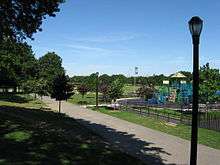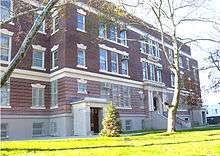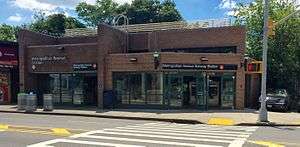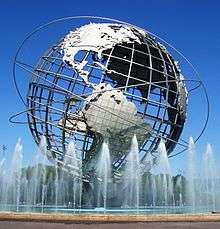Middle Village, Queens
| Middle Village | |
|---|---|
| Neighborhood of Queens | |
|
| |
 Middle Village  Middle Village  Middle Village | |
| Coordinates: 40°42′44.26″N 73°53′20.71″W / 40.7122944°N 73.8890861°W | |
| Country |
|
| State |
|
| City | New York City |
| County/Borough | Queens |
| Population (2000) | |
| • Total | 28,984 |
| Ethnicity | |
| • White | 83.9% |
| • Black | 0.7% |
| • Hispanic | 9.8% |
| • Asian | 4.0% |
| • Other | 3.2% |
| Economics[1] | |
| • Median income | $67,715 |
| ZIP code | 11379 |
| Area code(s) | 718, 347, 929, 917 |
Middle Village is a mainly residential neighborhood in the central section of the borough of Queens, New York City, bounded to the north by the Long Island Expressway, to the east by Woodhaven Boulevard, to the south by Cooper Avenue, and to the west by Mount Olivet Cemetery.[2] Middle Village also consists of a small trapezoid-shaped area bounded by Mt. Olivet Crescent to the east, Fresh Pond Road to the west, Eliot Avenue to the north, and Metropolitan Avenue to the south, though this is sometimes considered part of nearby Ridgewood.
Middle Village is bordered by the neighborhoods of Elmhurst to the north, Maspeth and Ridgewood to the west, Glendale to the south, and Rego Park to the east. In 2003, South Elmhurst, an area between Eliot Avenue and the Long Island Expressway, was reassigned from Elmhurst's ZIP code of 11373 to Middle Village's ZIP code of 11379. The neighborhood is part of Queens Community District 5, served by Queens Community Board 5.[3] Housing in the neighborhood is largely single-family homes with many attached homes, and small apartment buildings.
History
The area was settled around 1816 by people of English descent and was named in the early nineteenth century for its location as the midpoint between the then-towns of Williamsburg, Brooklyn, and Jamaica, Queens, on the Williamsburgh and Jamaica Turnpike (now Metropolitan Avenue), which opened in 1816.[2][4] It was generally sparsely populated because the large Juniper Swamp was in the area. The swamp, an area where the Americans hid from British in the American Revolutionary War, was originally circumscribed by a "Juniper Round Swamp Road".[5] In 1852, a Manhattan Lutheran church purchased the farmland on the western end of the hamlet.[4]
After the Civil War, the area became predominantly German.[4] The Williamsburgh and Jamaica Turnpike became an un-tolled road by 1873,[5] and St. John Roman Catholic Cemetery was laid out on the eastern side of the town in 1879.[6] Hotels and other services appeared to meet the needs of cemetery visitors.[2] The western part of Middle Village was called "Metropolitan" until prior to World War I.[5]
The Juniper Swamp was filled in 1915.[4][5] In 1920, the area was renamed "Juniper Valley" as part of a revitalization project. Shortly after, gangster Arnold Rothstein bought 88 acres (36 ha) of the land, erected facades of houses on that land, and tried to sell these houses, but not before he tried to sell the land to the city as an airport.[5][7]
A housing boom that began in the 1920s eventually consumed the surrounding farmland and became continuous with neighboring towns and neighborhoods.[4] Originally, homes were built by two major builders—the Nansen Building Corporation, and Baier & Bauer. Charles Baier's first project in the area was the Parkville Homes in 1927, a group of 30 homes at Juniper Valley Road and 77th Place. With Ridgewood developer August Bauer, they built 150 single-family row houses by 1928. In 1931, Bauer, collaborating with builder Paul Stier, built some 7-room houses at 78th Street and Furmanville Avenue.[8]
Demographics and crime
Based on data from the 2010 United States Census, the population of Middle Village was 37,929, an increase of 300 (0.8%) from the 37,629 counted in 2000. Covering an area of 1,329.29 acres (537.94 ha), the neighborhood had a population density of 28.5 inhabitants per acre (18,200/sq mi).[9]
The racial makeup of the neighborhood was 74.0% (28,071) White, 0.9% (354) African American, 0.1% (31) Native American, 8.1% (3,059) Asian, 0.0% (7) Pacific Islander, 0.2% (89) from other races, and 0.8% (314) from two or more races. Hispanic or Latino of any race were 15.8% (6,004) of the population.[10]
The population in Middle Village has been historically German American. Later, it became Irish American, Italian American, and Yugoslavian-American,[11] although Middle Village has seen an influx of Polish people, Eastern Europeans, Hispanic Americans, and Chinese Americans (mostly in South Elmhurst, after a ZIP code change in the early 2000s[12]). Many of the older families have left Middle Village but have not sold their homes but rather passed them down to their children; the result is many second and third generation residents.[13] The population of Middle Village has been relatively consistent: 28,984 in 2000, compared to 28,981 in 1990.[2]
The neighborhood has been historically relatively safe. During the 1970s and 1980s, when crime in New York City was at an all-time high, the Mafia allegedly prevented crime from happening. Although there have been several burglaries and grand theft autos in recent years, there is not a lot of violent crime.[14] As of 2014, the 104th Precinct (including Middle Village, plus the neighboring areas of Glendale, Ridgewood, and Maspeth) reported 3 murders (5 in 2001), 18 rapes (15 in 2001), 180 robberies (359 in 2001), 215 felonious assaults (262 in 2001), 292 burglaries (790 in 2001), 575 grand larcenies (551 in 2001), and 227 grand thefts auto (892 in 2001).[15]
Points of interest

Metro Mall is a shopping mall on Metropolitan Avenue just west of the neighborhood's subway station.[5] In 1920, the C.B. French Company, which made telephone booths for the American Telephone and Telegraph Company (now AT&T), built a factory on what is now the site of Metro Mall. After the C.B. French Company was acquired by the Turner-Armour Company, which was in turn acquired by the Western Electric Company, Western Electric continued to operate the plant and make telephone booths for AT&T. The plant was closed by around 1965, after which United Merchants and Manufacturers Inc. acquired the land and built a three-story mall on the site between 1972–4.[16]

The Frank T. Lang Building, at Metropolitan Avenue and 69th Street, was constructed in 1904.[5] It is named after Frank Lang, the building's namesake, who built mausoleums and monuments. The building, which sold mausoleums and monuments until 1946, also used to have an "H.C. Bohack" gas station, operated by the same man who also headed the Bohack's grocery store chain. The two-story art deco building is notable for imposing gargoyles and finely chiseled faces on its roof.[5][17]
Niederstein's, a renowned local restaurant, was located at 69-16 Metropolitan Avenue until it was demolished in 2005. The site, located near present-day 69th Street, was prime real estate in the early 19th century. Isaac Ferguson, who owned 7⁄12 acre (0.24 ha) of land at the site, sold 1⁄3 acre (0.13 ha) of his land to John Heuss, having been loath to give his land to the Geissenhainers of Lutheran Cemetery due to Ferguson's concerns that the tract was worth more than what the Geissenhainers would have paid for it. Huess later sold the land to Henry Schumacher, a then-27-year-old Württemberg native.[18] In 1850, Schumacher built a 2-story wooden roadside lodge, called the Schumacher's Lager Beer Saloon and Hotel, on the Williamsburgh and Jamaica Turnpike.[19] Ferguson sold the remaining 1⁄4 acre (0.10 ha) to Schumacher in 1864, by which time the area's hotels were booming in popularity. In 1888, Schumacher was dead and his wife, Catharina Sutter, sold the building and the business to John Niederstein, a German cook. Niederstein built 32 rooms with two wings and operated the lodge as a hotel. Henrietta Gabriel, John Niederstein's granddaughter, bought the business from Grace, Niederstein's daughter-in-law, in 1920.[18] In 1969, Gabriel sold the hotel to Reiner and Horst Herink, who operated the structure as a restaurant.[19] Once patronized by 130 thousand annual diners, the restaurant became less popular by the 1990s. Because of its many modifications, the building was ineligible for landmarking by the New York City Landmarks Preservation Commission. The property was sold in the early 2000s and demolished in September 2005 to make way for an Arby's restaurant.[11][18][19]
A volunteer fire department, Fearless Hook and Ladder Company No. 7, operated at 71-55 Metropolitan Avenue from 1891 until 1986.[11]
The Arion Theater, a one-screen, 970-seat theater at Metropolitan Avenue and 74th Street, was built in 1921 and was the first theater in Queens that had wiring for loudspeakers. It closed in the mid-1980s because of a never-implemented plan to turn the structure into a triplex. Instead, the theater was converted to a RiteAid drugstore—which closed in 2009—and then to a Spirit Halloween superstore. As of 2016, the site is a Salvation Army location.[5][20]
The Artistic Building, on Metropolitan Avenue between 79th and 80th Streets, is a 1930 structure that is notable for having friezes of biblical scenes on its facade. As of 2005, it was a tailor's shop.[5]
There are also some very old houses in Middle Village. The Morrell House, built by English settler Thomas Morrell, was built in 1719 on present-day Juniper Valley Road; the house was demolished in 1985.[5] By 1995, two other historical houses were slated for demolition by the same developer who demolished the Morrell House.[21] In 2005, though, the Juniper Park Civic Association successfully petitioned to get parts of Maspeth and Middle Village rezoned to prevent aggressive redevelopment.[5] An old farmhouse on Furmanville Avenue, built in the 1890s, still exists as of 2005.[5]
Cemeteries and crematory
The Lutheran-All Faiths Cemetery, at 67-29 Metropolitan Avenue, opened in Middle Village in 1852, due to 1847 regulations that banned new cemeteries in Manhattan.[5] The General Slocum Steamboat Fire Mass Memorial, commemorating the 1904 sinking of the PS General Slocum that killed 1,021 people, is at Lutheran All Faiths Cemetery.[14][22]
Near the Lutheran-All Faiths Cemetery, on Mount Olivet Crescent, is the Fresh Pond Crematory and Columbarium, which has operated since the late 19th century. Baseball player Lou Gehrig, screenwriter Ring Lardner, Sr., businessman J.P. Morgan, and carpenter Richard Hauptmann—notable for the Lindbergh kidnapping—are among the people cremated there.[5] The crematory, the third-oldest in the United States, was erected in 1884 and started cremating people a year later. The columbarium was built in 1893 and expanded in 1898; the two-building complex was further enlarged in 1904 and 1910.[23]
The Pullis Farm Cemetery, a small burial plot in Juniper Valley Park, is a gated mini-cemetery dating back to 1846. As many as eight members of the Pullis family are interred in the plot. The cemetery became overgrown was weeds and was restored in 1993–6 with a new headstone. It is one of the few farm burial grounds still located in New York City.[5][24]
Many famous dead people's graves are located in Middle Village. St. John Cemetery, a cemetery located in Middle Village, holds many famed mobsters, including John Gotti, Lucky Luciano, Joe Gallo, Carlo Gambino, Joseph Profaci, Joe Colombo, Vito Genovese and Carmine Galante. Also buried here are fitness guru Charles Atlas, politicians Geraldine Ferraro and Mario Cuomo, slain New York police officer Rafael Ramos, and photographer Robert Mapplethorpe.[5][14]
Religious institutions
The United Community Methodist Church (founded as the Methodist Episcopal Church of Newtown), the first Methodist church in Middle Village, is located near the present-day intersection of Juniper Valley Road and 80th Street. The church, originally built in 1769, was moved to Metropolitan Avenue near 75th Street in 1836, and was rebuilt in 1901 and 1926.[5]
The Trinity Lutheran Church was founded in 1851 in the Lutheran-All Faiths Cemetery. A school was founded in the church in 1861, and the church burned just two years later. Then, it moved to 69th Street. At the 69th Street site, the school burned down in 1895 and the church burned down in 1906. Another church was built on the 69th Street site, but it was structurally damaged by lightning damage in 1975 and completely burned in a 1977 fire. The church's third structure, built in 1979, is located on a plot of land bounded by present-day Penelope Avenue, Dry Harbor Road, Juniper Boulevard South, and 81st Street. The bells and cornerstones from the first two churches are the only remnants of the original structures, and are located in front of the original church.[5][25]
St. Margaret’s Roman Catholic Church, a church and attached school built in 1860, was used during the American Civil War as a temporary jail. The church and school were both reconstructed—the school in 1899 and the church in 1907. In 1935, they moved to a four-story structure on Juniper Valley Road near 80th Street.[5]
Our Lady of Hope is a hexagonal structure on Eliot Avenue with a bell tower and is located just north of the New York Connecting Railroad. The church was built in 1965.[5]
There used to be many synagogues in Middle Village, due to an influx of Jewish residents in the early 20th century. The Hebrew Institute of Middle Village was a rabbinical seminary, built in 1919 next to a synagogue that existed from 1909 to the 1970s; the building that housed the Hebrew Institute of Middle Village is now occupied by the Middle Village Adult Center. The Holy Archangels Michael & Gabriel Romanian Orthodox Church moved into a former synagogue in 1997, but the synagogue itself dates back to 1921. The only extant synagogue in the area, the Congregation of Forest Hills West, was founded in 1935.[5]
Parks and recreation

Northern Middle Village is served by Juniper Valley Park, a large public park built in 1930 on the former Juniper Swamp.[26] There are tennis, handball, basketball, and bocce courts, as well as seven baseball fields and a quarter-mile running track around a turf football/soccer field.[7]
Another park, the Middle Village Playground, is located at 79th Street between 68th Road and 69th Avenue, in southern Middle Village. The city of New York bought the property in 1938 and renovated the playground in 1994.[27]
The Middle Village Veteran's Triangle, at Gray and 77th Streets, commemorates local people who were veterans of World War I, World War II, the Korean War, and the Vietnam War. It was renovated in 1999.[28]
Schools

Elementary and junior high schools with grades K–8 include PS/IS 49,[29] PS/IS 128,[30] and PS 87.[31]
Our Lady of Hope, St. Margaret, and Resurrection-Ascension are three Catholic K-8 schools in the area, and Christ The King Regional High School is another parochial school in the area.
Transportation

The neighborhood is served by the M train of the New York City Subway, which terminates at the Metropolitan Avenue station.[32] In addition, five local bus lines serve Middle Village: the Q29, Q38, Q47, Q54, and Q67. The QM24, QM25, and QM34 express bus routes to Manhattan also serve the neighborhood.[33]
Notable people
Notable current and former residents of Middle Village include:
- Nicole Bass (born 1964), professional female bodybuilder[34]
- Carl Berner (1902-2013), supercentenarian[35]
- William N. Conrad (1889-1968), politician who served in the New York State Senate[36]
- Donna DeCunzo-Taddeo, creator of EDiets.com, CEO of Voodoo Tiki, producer of Zoom Suit[37]
- Hyman Golden (1923-2008), co-founder of the Snapple Beverage Corporation[38]
- Vincent Piazza (born 1976), film, television and stage actor best known for his roles in the television series Boardwalk Empire, the 2007 film Rocket Science, and as Tommy DeVito in the film adaptation of Jersey Boys[39]
- Mike Repole, CEO/creator of Vitamin Water[37][40]
See also
References
- ↑ "11379 Zip Code in Middle Village, NY - Neighborhoods, Schools, Real Estate, Demographics and Relocation Tools". neighborhoodlink.com.
- 1 2 3 4 "A Halfway Point Where People Tend to Stay". The New York Times. October 5, 2008. Retrieved June 5, 2015.
- ↑ Queens Community Boards, New York City. Accessed September 3, 2007.
- 1 2 3 4 5 Jackson, Kenneth T., ed. (1995), The Encyclopedia of New York City, New Haven: Yale University Press, ISBN 0300055366
- 1 2 3 4 5 6 7 8 9 10 11 12 13 14 15 16 17 18 19 20 21 22 Walsh, Kevin (April 2005). "MIDDLE VILLAGE, Queens". Forgotten NY. Retrieved June 5, 2015.
- ↑ Seyfried, V.F. and Asadorian, W. (1991). Old Queens, NY in Early Photographs, Mineola, NY: Dover.
- 1 2 Juniper Valley Park, New York City Department of Parks and Recreation. Accessed May 16, 2008.
- ↑ Christina Wilkinson (June 2015). "The development of Middle Village in the 1920s". Juniper Park Civic Association. Retrieved June 25, 2015.
- ↑ Table PL-P5 NTA: Total Population and Persons Per Acre - New York City Neighborhood Tabulation Areas*, 2010, Population Division - New York City Department of City Planning, February 2012. Accessed May 20, 2016.
- ↑ Table PL-P3A NTA: Total Population by Mutually Exclusive Race and Hispanic Origin - New York City Neighborhood Tabulation Areas*, 2010, Population Division - New York City Department of City Planning, March 29, 2011. Accessed May 20, 2016.
- 1 2 3 "Middle Village NY History". Middle Village NY. Retrieved June 7, 2015.
- ↑ John Roleke. "Neighborhood Profile of Elmhurst in Queens, NY". About.com Travel.
- ↑ 11379 Zip Code Detailed Profile, City-data.com.
- 1 2 3 Roleke, John. "Middle Village, NY: Queens Neighborhood Profile". About.com Travel. Retrieved June 7, 2015.
- ↑ "CompStat 104th Precinct" (PDF). New York City Police Department. Retrieved June 7, 2015.
- ↑ "The Telephone Improved Communication, Changed The Face Of Middle Village". Times News Weekly. August 22, 2002. Archived from the original on July 9, 2003. Retrieved June 7, 2015.
- ↑ Ron Marzlock (October 22, 2008). "Frank T. Lang Building, Middle Village". Queens Chronicle. Retrieved June 7, 2015.
- 1 2 3 Dorothy Speer. "History of Niederstein's". Juniper Civic Association. Retrieved June 7, 2015.
- 1 2 3 Walsh, Kevin (September 2008). "REMEMBERING NIEDERSTEIN'S". Forgotten NY. Retrieved June 7, 2015.
- ↑ "Arion Theatre". Retrieved June 7, 2015.
- ↑ Pete Donohue (July 19, 1995). "Row Over Plan to Raze Middle Village Houses". New York Daily News. Retrieved June 7, 2015.
- ↑ "Find A Grave - Middle Village". findagrave.com.
- ↑ Patrick E. McCarthy. "Ashes to Ashes". Juniper Civic Association. Retrieved June 7, 2015.
- ↑ Paul Toomey (June 13, 2002). "Middle Village Man Breathes New Life Into Farm Cemetery". Retrieved June 7, 2015.
- ↑ Joyce Beaudoin. "The History of Middle Village's Trinity Lutheran Church". Juniper Civic Association. Retrieved June 7, 2015.
- ↑ Brooklyn Standard Union-March 7, 1931-News Accessed May 16, 2008.
- ↑ "Middle Village Playground". NYC Parks. Retrieved June 7, 2015.
- ↑ "Middle Village Veterans Triangle". NYC Parks. Retrieved June 7, 2015.
- ↑ PS/IS 49, New York City Department of Education website
- ↑ PS 128, New York City Department of Education website
- ↑ PS 87, New York City Department of Education website
- ↑ "Subway Map" (PDF). Metropolitan Transportation Authority. November 2016. Retrieved November 7, 2016.
- ↑ "Queens Bus Map" (PDF). Metropolitan Transportation Authority. 2016. Retrieved 2016-07-16.
- ↑ Levy, Margo; and Celona, Larry. "Pro wrestling diva Nicole Bass busted for stealing groceries", New York Post, June 24, 2015. Accessed May 20, 2016. "She declined comment outside her Middle Village home as she returned Wednesday afternoon — still carrying a Stop & Shop bag."
- ↑ Colangelo, Lisa L. "Carl Berner, Queens supercentenarian and civic leader, dies at 110", New York Daily News, January 8, 2013. Accessed May 20, 2016. "Carl Berner, the Middle Village resident who championed his community and set a new benchmark for staying active well past his tenth decade, died at his home on Monday just weeks before his 111th birthday."
- ↑ The New York Red Book, Volumes 56-59; Volume 63, p. 113. Williams Press, 1947. Accessed May 22, 2016. "William N. Conrad was born in Middle Village, L. I., August 17, 1889."
- 1 2 Shusterich, Edward (December 2013). "Profile of Middle Village". JuniperCivic.com. Retrieved 2016-05-22.
Mike Repole, CEO of Glaceau Vitaminwater, and Donna DeCunzo-Taddeo, President of Voodoo Tiki Tequila Corp., also have roots in Middle Village
- ↑ O'Connor, Ahmad. "Hyman Golden, Co-Founder of Snapple, Dies at 85", The New York Times, September 20, 2008. Accessed May 22, 2016. "Hyman Golden was born in 1923 in Passaic, N.J., and raised in the Middle Village section of Queens."
- ↑ Rennison, Billy. "Vincent Piazza dishes on going from Queens to the 'Boardwalk'", Queens Courier, September 14, 2012. Accessed May 22, 2016. "Vincent Piazza — born in Middle Village before moving to neighboring Maspeth shortly thereafter, where his family still lives — grew up watching the films of Martin Scorsese, never imagining he would one day be directed by the film giant."
- ↑ Burns, Mark J. "Think Big, Dream Bigger: Mike Repole's Journey To Becoming Co-Founder Of BODYARMOR", Forbes, October 13, 2004. Accessed May 22, 2016. "Growing up as a teenager in Middle Village, Queens, Mike Repole had two loves: sports and business."
External links
| Wikimedia Commons has media related to Middle Village, Queens. |
Coordinates: 40°43′2.48″N 73°52′27.02″W / 40.7173556°N 73.8741722°W
